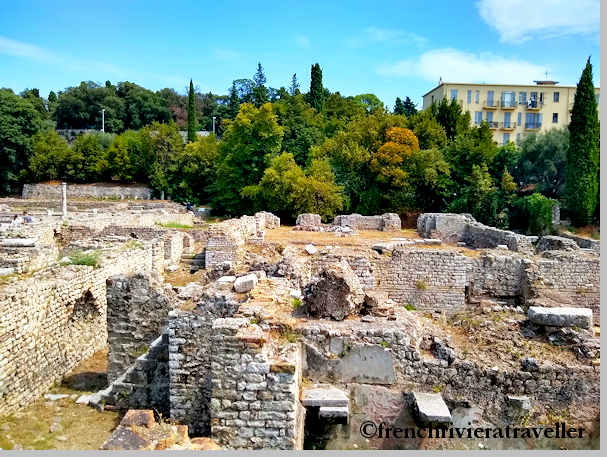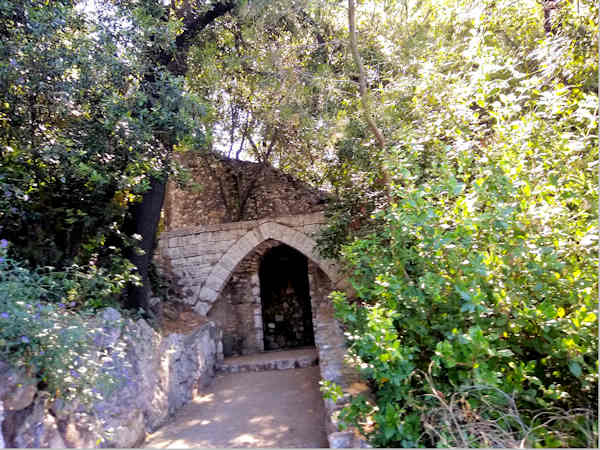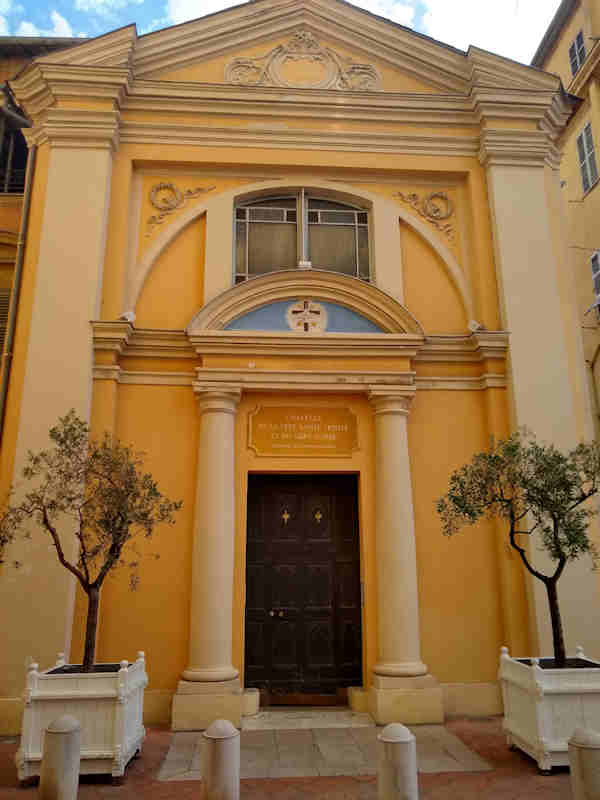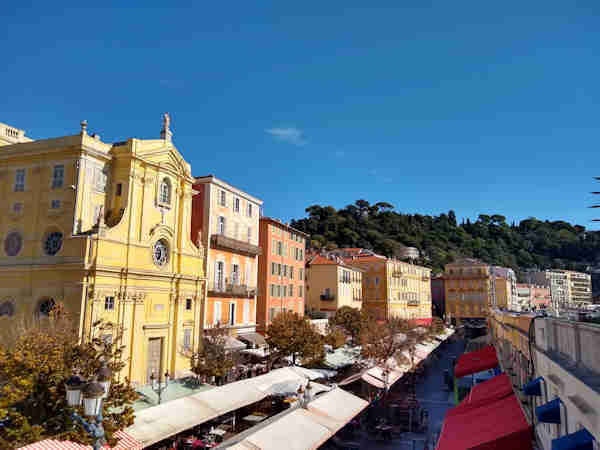Nice's story begins around the 3rd century BC when ancient Greeks from Phocaea established a colony on the Colline du Chateau, probably supplanting the Ligurian population. Little is known about this early settlement except that it established trade links with another Greek colony, Massalia, now Marseille. The colony became known as Nikaia, possibly after Nike, the Greek word for victory. Although no remnants of the Greek settlement remain, it was these ancient settlers who introduced olive trees and grape vines to the region.
Romans swept through the region in the 2nd century BC and established a military outpost, Cemenelum, on top of Cimiez hill. Strategically located along the Via Julia between Spain and Italy, Cemenelum became the Roman capital of the Alpes Maritimes province. The population was about 10,000 people which included the Ligurian tribes under Roman authority. Roman baths and an amphitheater on Cimiez hill are vivid reminders of the Roman presence.

Roman baths at Cimiez
Meanwhile, Christianity arrived in the region. Two Christian martyrs-Saint Pontius and Saint Reparata-left an enduring mark on Nice's spiritual life. Saint Pontius was beheaded in 257AD under the Emperor Valerian. Five centuries later the influential Saint Pons abbey was built on the site of his burial spot. Saint Reparata was martyred in Palestine in the 3rd century and, according to legend, floated to Nice in a boat accompanied by angels. Nice's cathedral Sainte Réparate is dedicated to her.
By the time of Rome's fall in 476, there was enough of a Christian community to support the construction of two churches. Both Cimiez and the Colline du Chateau contain remnants of these early churches that date from the 5th century. It's supposed that there was also a Jewish community that dated from the 3rd century.
The fall of Rome marked the beginning of a high-conflict era in Nice. First there was the Visigoth invasion. Cimiez could not be defended and was gradually abandoned. The Ostrogoths arrived only to be driven out when Nice became part of the Eastern Roman empire in 550.
After the Lombard conquest of Nice in 641 Nice became part of Liguria and recognized Genoa as its capital. Although interrupted by devastating Saracen raids in the 9th century and then a period of domination by the hated Counts of Provence, Nice remained closely allied with Genoa. Finally in 1229 the Provencal Count Raymond Berenger V conquered the city.
During the 13th century Nice's population expanded and its economy strengthened, largely due to the burgeoning salt trade. Population pressures pushed inhabitants down from the walled Colline du Chateau to the eastern part of Vieux Nice where the Franciscans built a church and monastery. Walls were built to protect the settlers.
Matters took a turn for the worse in the 14th century. The bubonic plague ripped through town from 1347 to 1348, then again in 1359 and 1373, cutting the population in half. No sooner had the plague receded than a new threat arose when the Provencal Countess Joanna died without a successor. A civil war erupted and Nice, unluckily, backed the wrong faction. The town was forced to turn to Count Amadeus VII of Savoy for protection. Nice voluntarily became part of the House of Savoy in 1388, an event that determined the city's development for almost five centuries.
Nice flourished under the new management. The old nobility fled to Provence and a new order of ennobled merchants rose to power. Along with neighboring Villefranche, Nice became Savoy's only seaport and grew prosperous again from the salt trade. The Savoy dukes protected their new possession by fortifying the Colline du Chateau. A Jewish community developed composed of immigrants fleeing persecution elsewhere in France. Some settled on rue Benoit Bunico in Vieux Nice; others settled around the Port.

Remains of Chateau on Castle Hill
The early 16th century ushered in a period of turbulence, mainly because Savoy became enmeshed in wars between the King of France, François I, and Emperor Charles V. A peace deal between the warring parties was negotiated in Nice in 1538 but it fizzled. As Savoy was allied with Charles V, Nice came under attack from a Franco-Turk alliance in 1543. During the assault, a washerwoman, Catherine Segurane, allegedly climbed on top the town's ramparts, seized a Turkish flag and wiped her bottom with it. The horrified Turks fled, saving the fortified Colline du Chateau, but Vieux Nice was pillaged before the attackers were driven out.
The siege was a seminal event in Nice's history. Catherine Segurane became a popular local heroine, symbolizing the fiercely independent Nice spirit. Cannonballs from the assault are displayed (triumphantly?) in and around Vieux Nice. Following the devastating assault, the Savoy dukes decided to turn the Colline du Chateau into a fortified citadel. New towers surrounded the citadel and civilians were sent to Vieux Nice.
The population increase ushered in a golden age for the Old Town. Making Nice a port franc in 1612, in which port taxes were abolished, boosted trade and commerce. Flush with cash, rich merchants built residences such as the Palais Lascaris or Palais Caïs de Pierlas in the Old Town. They also financed the construction or expansion of numerous churches including the venerable Cathedral of Sainte Réparate.
The building spree that lasted from the mid-17th to late 18th century coincided with the great era of baroque architecture. Under pressure from the Protestant Reformation, the Catholic church introduced this highly theatrical, richly decorated style that aimed to surprise and awe churchgoers. The lighting was dramatic, the colors vibrant, and the eye drawn upwards toward heaven.
Originating in Italy the style was quickly adopted in Nice and applied to both sacral and civil structures. Vieux Nice contains a profusion of stunning baroque churches that mix Genoese and Piedmont styles. Eglise de Gesu, Chapelle de la Miséricorde, L'Eglise de l'Annonciation, and the lavish Cathedral Sainte Réparate are the most splendid examples of baroque style. The Palais Lascaris and Palais Corvésy show how powerful families used baroque style to display their wealth.

Church of Sainte Claire
A flourishing economy and artistic life failed to cushion Nice from an ominous political situation. Once again Savoy, France and Spain were locked in a power struggle that erupted when French forces under Louis XIV occupied Savoy and Nice in 1691. Although the Treaty of Turin returned Nice to Savoy in 1697, peace was short-lived. The War of Spanish Succession broke out and Savoy broke its alliance with France who promptly attacked Nice again. The city capitulated at the end of 1705 and in 1706 French forces demolished the Chateau, reducing the walls, towers and bastions to rubble. Nice lost its military function and became part of France until it was returned to Savoy in 1748.
As Nice was no longer a military outpost worth attacking, the city was free to concentrate on expansion and beautification. Grand public spaces such as the Cours Saleya and Place Garibaldi emerged, a new cemetery opened for burials on the Colline du Chateau, and the farmlands of west Nice finally got a parish church (Sainte Hélène). Construction began on the Port Lympia which was linked to Turin by a new road. Most importantly, the town became known to English aristocrats thanks to Scottish writer Tobias Smollett who wrote a bestseller about his experience in mid-18th century Nice. The first winter tourists began arriving, sparking Nice's eventual identity as a tourist destination.

Cours Saleya
When the French Revolution broke out in 1789, Savoy was left flatfooted. The duchy had little sympathy with revolutionary sentiments and allied with Austria to repel the Revolutionary army marching through Europe. Nice and the surrounding region were occupied and annexed to France following a "vote" that was neither free nor fair.
The period following the annexation was tumultuous with various factions fighting for or against the French, mostly in the hinterlands. The anti-clericalism of the Revolutionary regime was highly unpopular in Nice which saw its old religious orders-Franciscans, Jesuits, Dominicans, Carmelites, Minims-driven out. Also unpopular was the corruption of local officials which allowed men such as Andre Gastaud to buy up a vast chunk of land in west Nice. Abolishing Nice's status as a port franc dealt a blow to the local economy.
Heroes also emerged during the post-Revolutionary period. When Napoleon Bonaparte launched his Italian campaign from Nice in 1796, he recruited a local officer, Andre Masséna, whose name is commemorated throughout town. Born in Nice in 1758 to a family of merchants, Masséna enlisted in the French army and quickly rose through the ranks despite his humble origins. He served with distinction in Bonaparte's Italian campaign and was made a Marshal of the Empire in 1804. The Emperor affectionately nicknamed him "the darling of victory".
By the beginning of the 19th century, Nice soured on the empire along with the rest of France. When Napoleon abdicated in 1814 the Treaty of Paris returned Nice to Savoy, now known as the Kingdom of Savoy-Sardinia. It was a welcome change as "Frenchification" never caught on in Nice. Locals remained attached to their language, Nissart, and their many religious traditions despite an influx of French immigrants.
The kingdom lost no time in restoring Nice's sputtering economy and improving the infrastructure that had been allowed to languish. They modernized the city with public lighting and paved roads and turned the ruins of the old Chateau into a park. Nice's status as port franc was restored and the port was enlarged. Construction of the Pont Neuf over the Paillon river in 1824 allowed the town to expand westward.
The expansion project was vital because tourism was becoming an increasingly significant part of the local economy. The trickle of English visitors in the 18th century became a steady stream, growing in size throughout the 19th century. Other nationalities followed-French, Germans, Russians and Americans-lured by the mild winters and vistas of sun, sea and mountains. The English had already "colonized" the Croix de Marbre neighborhood across the river and called it Newborough. In 1824 they built the forerunner of the Promenade des Anglais, the Chemin des Anglais.
To manage an expanding and modernizing city, Savoy appointed an urban planning commission, the Consiglio d'Ornato, composed of prominent local merchants, nobles, jurists and architects. The commission proposed new roads, public spaces and infrastructure projects, regulated the style of buildings, the size of boulevards and the organization of streets. All building projects needed the commission's approval. Its primary focus were the neighborhoods popular with foreigners: the rue Saint François-de-Paule and nearby streets, the right quay of the Paillon river, the Promenade des Anglais and Newborough. Under its direction the Place Masséna, Jardin Albert 1er, and avenue Jean Médecin were laid out while Place Garibaldi and Port Lympia gained elegant new buildings. As Vieux Nice was considered poor and decrepit, that part of town was mostly left alone.
The urban improvements endeared the Niçois to their Savoy-Sardinian masters but the good feelings came to an abrupt halt when their overlords abolished Nice's status as a port franc in 1853. The great port of Genoa became the star of Piedmont, condemning Nice's little Port Lympia to irrelevance. It was a devastating blow to the local economy and led to violent demonstrations.
The port issue was also a key factor in Nice deciding to become a part of France in 1860. The Sardinian king needed the assistance of France to expel the Austrians who had invaded central Italy and impeded his project of Italian unification. France was willing to help because a unified Italy provided a counterweight to powerful Austria. All was settled by the treaty of Turin in 1860 in which France aided Savoy-Sardinia in their struggle against Austria in exchange for Nice and Savoy. The rulers set up a referendum to validate the decision. Although the local population was initially divided, bitterness about the port coupled with pressure from the pro-France clergy, civil service and economic elites carried the day. The vote was 25,743 for and 160 against unification. And so ended five centuries of Savoy influence.
Unification accelerated Nice's development as a tourist destination. With the opening of the train station in 1864, the Paris-Nice train disgorged a parade of wealthy or titled visitors. They poured into richly decorated hotels along the Promenade des Anglais and Cimiez or built elaborate mansions in the new Quartier des Musiciens neighborhood. Some created vast estates in west Nice. Belle Epoque style was in vogue and architects vied to construct the most ornate, opulent structures the owners could afford. Nice became the European capital of fun and entertainment.
Nice's urbanization was entirely structured on the goal of creating a tourist resort by the sea. It was a novel idea at the time and was why Unesco designated these newer neighborhoods of Nice as a World Heritage Site.
The party came to an end with the outbreak of WWI in 1914. As tourists fled and the grand hotels were turned into military hospitals, the local economy crumbled. 3665 Niçois gave their lives in WWI; their deaths were commemorated on the Monument Aux Morts.
After the war, British visitors returned but the now impecunious Russians were replaced by a new generation of Americans. Eschewing the old-fashioned Belle Epoque palaces in Cimiez, these young visitors flocked to the hotels along the Promenade des Anglais, attracted to the terrace bars, casinos and swimming pools. Sea-bathing came into fashion and Nice became a summer destination. There were regattas in the Baie des Anges and auto races on the newly widened Promenade des Anglais. Jazz musicians such as Louis Armstrong came to play and artists such as Matisse and Raoul Dufy came to paint. Unlike 19th century visitors, no one came for their "health". They came to party.
The interwar period also saw the emergence of a new style of architecture: Art Deco. Gone were the cherub-infested friezes that characterized Belle Epoque buildings. Instead, architects opted for clean, geometric lines and buildings decorated with mosaics, ceramics and paintings inspired by nature. They experimented with a variety of materials: reinforced concrete, stone and brick, sometimes all in the same structure. Right angles were banished in favor of rounded corners. Bow windows add visual interest to the facades and ironwork patterns enliven doors, railings and balconies. The apogee of Art Deco style is the Palais de la Méditerranée on the Promenade des Anglais but the style is most prevalent in the Quartier des Musiciens.
WWII was a time of tremendous hardship in Nice. The Italian occupation (1940-1943) raised fears that Nice would once again become part of Italy. Resistors engaged in sabotage were duly jailed and tortured by Italian authorities based in Cimiez. The Italians were unenthused about deporting the Jewish population so many French Jews flocked to Nice as a safe haven.
The German occupation that lasted from December 1943 to August 1944 was far harsher. Over 3000 Jews were either deported or shot on the spot under German occupation. The Germans militarized the Colline du Chateau and used it to bombard the Old Town in the final days of the war. Throughout both occupations hunger, if not outright famine, was widespread throughout Nice as food supplies were disrupted.
After the war Nice rebuilt and then built and built to accommodate a growing population. New apartment buildings replaced the old villas in Cimiez. Sprawling estates in west Nice were torn down in favor of public parks and posh residences. Decrepit neighborhoods in Vieux Nice were razed and rebuilt in traditional style. A new airport arose in response to the demands of mass tourism.
Nice's modernization continued in the 21st century with the construction of two tramway lines to relieve gnarled traffic in the town center. New bike lanes crisscross the town, making bicycles a pleasant mode of transport and recreation. The Promenade de Paillon or Coulée Vert turned the covered Paillon river into an oasis of greenery.
Ambitious new projects centered around the airport and train station are in development with the aim of attracting business travelers. Surely the century will see even more changes in this ancient yet always modern city.